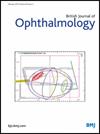Exploring risk factors for axial length elongation: a population-based cohort study of 9195 eyes in Japan
IF 3.5
2区 医学
Q1 OPHTHALMOLOGY
引用次数: 0
Abstract
Purpose To investigate long-term axial length (AL) changes in adults and to identify risk factors contributing to excessive AL elongation, which is associated with high myopia, we analysed a large dataset of adults without ocular pathology from the Tohoku Medical Megabank Project Community-based Cohort Study in Japan. Methods We conducted a longitudinal investigation of 9195 participants aged ≥20 years with several years of follow-up (mean 3.5 years). Based on the upper quartile of AL elongation for people aged in their 20s, we defined AL elongation exceeding 0.033 mm per year as high AL elongation (HALE). We used multiple logistic regression analyses to assess potential risk factors for HALE. Results A longitudinal investigation revealed that AL can fluctuate and even become elongated during adulthood, particularly among middle-aged and older individuals. Notably, HALE occurred in 618 out of 9195 eyes (6.7%). The proportion in each age group, comprising people aged in their 20s, 30s, 40s, 50s, 60s, 70s and 80s, was 24.7%, 12.7%, 9.4%, 5.2%, 4.5%, 4.0% and 1.4%, respectively. In addition, we also observed that younger age (OR 1.45 per 10 years older), female gender (OR 1.63), high myopia (OR 2.74) and serum immunoglobulin E (IgE) levels >171 IU/mL (OR 1.27) were associated with HALE. Conclusion Findings from a large prospective cohort study confirmed that in Japanese individuals, HALE was significantly associated with high serum IgE levels, as well as with younger age, female gender and pre-existing high myopia. The principal investigator, TN, had full access to all the data in the study and takes responsibility for the integrity of the data and the accuracy of the data analysis. The data that support the findings of this study are available from the corresponding author, HK, and the principal investigator, TN, upon reasonable request.探讨眼轴长度延长的危险因素:日本9195只眼的人群队列研究
为了研究成人的长期眼轴长度(AL)变化,并确定导致与高度近视相关的AL过度伸长的危险因素,我们分析了来自日本东北医学大银行项目社区队列研究的无眼部病理的成人大数据集。方法对9195名年龄≥20岁的参与者进行了纵向调查,随访数年(平均3.5年)。根据20多岁人群AL伸长率的上四分位数,我们将AL伸长率超过0.033 mm /年定义为高AL伸长率(HALE)。我们使用多元逻辑回归分析来评估HALE的潜在危险因素。结果一项纵向调查显示,AL在成年期可以波动甚至变长,特别是在中老年人群中。值得注意的是,9195只眼中有618只(6.7%)出现HALE。各年龄段(20多岁、30多岁、40多岁、50多岁、60多岁、70多岁和80多岁)的比例分别为24.7%、12.7%、9.4%、5.2%、4.5%、4.0%和1.4%。此外,我们还观察到年龄较小(OR为1.45 / 10岁)、女性(OR为1.63)、高度近视(OR为2.74)和血清免疫球蛋白E (IgE)水平bb0 171 IU/mL (OR为1.27)与HALE相关。结论一项大型前瞻性队列研究的结果证实,在日本个体中,HALE与血清IgE水平高、年龄小、女性和既往高度近视显著相关。首席研究员TN对研究中的所有数据有完全的访问权,并对数据的完整性和数据分析的准确性负责。支持本研究结果的数据可应通讯作者HK和首席研究员TN的合理要求提供。
本文章由计算机程序翻译,如有差异,请以英文原文为准。
求助全文
约1分钟内获得全文
求助全文
来源期刊
CiteScore
10.30
自引率
2.40%
发文量
213
审稿时长
3-6 weeks
期刊介绍:
The British Journal of Ophthalmology (BJO) is an international peer-reviewed journal for ophthalmologists and visual science specialists. BJO publishes clinical investigations, clinical observations, and clinically relevant laboratory investigations related to ophthalmology. It also provides major reviews and also publishes manuscripts covering regional issues in a global context.

 求助内容:
求助内容: 应助结果提醒方式:
应助结果提醒方式:


